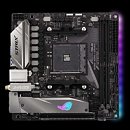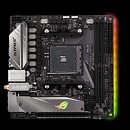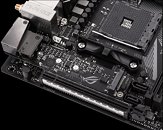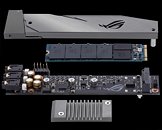Thursday, October 19th 2017

ASUS Announces ROG STRIX X370-I And B350-I Mini-ITX Motherboards For AMD Ryzen
Mini-ITX boards are among the most difficult to produce. Their diminutive 6.7" x 6.7" dimensions leave little real estate for slots and ports, let alone the extra features that make ROG unique. We're not willing to compromise your experience for a compact footprint, so it takes some time and creativity to make everything fit. But it's worth the effort, because our new Strix X370-I Gaming and Strix B350-I Gaming motherboards for Socket AM4 raise the bar for small-form-factor Ryzen builds. They match the cutting-edge features of their full-sized siblings, including liquid-ready cooling and addressable RGB lighting, and they combine an M.2 SSD heatsink and amped-up audio on an innovative riser card.Optimized overclocking on liquid or air
Ryzen CPUs are physically much larger than the Intel alternatives, adding another layer to an already challenging proposition. The extra area is well-spent, though. With up to eight Zen-based CPU cores primed for heavy multitasking and multithreaded workloads, Ryzen offers exceptional performance and value for game streamers, content creators, and power users who want to do more with their PCs.
Unlocked multipliers make Ryzen overclocking accessible for everyone, and the Strix X370-I and B350-I Gaming take full advantage. They feature the same six-phase VRM design as our full-sized ATX boards for AM4, ensuring stable power delivery well above stock speeds. They're also built for the higher memory clocks required to fully unleash the platform's potential. The shorter traces used for the dual-DIMM configuration improve signaling, enabling DDR4-3600 speeds that surpass what's supported by competing motherboards.
Our exclusive 5-Way Optimization technology simplifies the overclocking process for beginners and experts. This intelligent auto-tuner automatically overclocks the CPU and configures the cooling based on the individual characteristics of components in your build. First-timers can overclock easily with a single click, while veterans can quickly find a stable baseline before moving to more aggressive manual tuning. And both benefit from 5-Way's ability to test connected fans and calibrate their response curves accordingly.
There are three fan headers onboard, one of which is configured out of the box for liquid pumps and all-in-one coolers. All the headers adapt automatically to three-pin DC or four-pin PWM devices. Instead of being bound to a single temperature sensor, each header can control fan speeds based on input from a group of multiple sensors. Along with the ability to detect GPU temperatures in select graphics cards, this capability ensures efficient cooling for a wide range of workloads, including gaming and other graphics-heavy work.
Audio and storage that think outside the form factor
The Republic of Gamers has a history of working around Mini-ITX limitations by building up with additional circuit boards. Our Maximus Impact series made room for upgraded audio with a dedicated riser, and the Strix X370-I and B350-I Gaming go one step further with an M.2 Audio Combo card that contains both SupremeFX sound and M.2 storage. This small PCB is sandwiched between isolated heatsinks for an M.2 drive and the platform chipset, ensuring effective cooling without taking up too much space.M.2 SSDs can throttle performance under sustained workloads that generate too much heat, and smaller Mini-ITX chassis present an especially toasty thermal environment. To help maintain performance when you need it most, the combo card reduces SSD temperatures with a custom heatsink. The M.2 slot supports the fastest NVMe drives with four lanes of Gen3 bandwidth directly from the CPU. It's joined by a secondary M.2 slot on the back side of the motherboard, allowing you to run two SSDs without any cable clutter.
The SupremeFX audio is linked to a dedicated chipset interface, so it doesn't share bandwidth with the primary M.2 slot. Its shielded S1220A codec routes audio output through headphone amplification capable of detecting and adjusting for the impedance of your headset. All of the audio circuitry is elevated off the motherboard, which helps isolate it from interference and improve overall fidelity. This is especially important for Mini-ITX motherboards that lack expansion capacity for a separate sound card.
Fully equipped in a fraction of the footprint
A single graphics card is all that's needed for high-end gaming and VR machines, but GPU coolers are increasingly heavy, which puts additional strain on the PCI Express slot. Our SafeSlot reinforcements guard against damage from the bumps and rough handling that can occur when transporting systems to LANs and shipping them to customers. The PCIe x16 slot is secured to the circuit board with extra solder points, and its walls are reinforced with metal bracing.
Onboard WiFi supplies fast 802.11ac connectivity spread over dual bands and a 2x2 antenna. The wireless module has MU-MIMO support to improve performance with compatible devices, plus Bluetooth for peripherals. Serious online gaming requires a wired connection, so the boards add a reliable Intel Gigabit Ethernet controller backed by GameFirst IV traffic prioritization software.With four SATA ports, there's plenty of capacity for hard drives and additional SSDs. Around back, you get dual USB 3.1 Gen 2 ports with 10Gbps of bandwidth for fast external storage. They're paired with four Gen1 USB ports linked directly to the CPU, along with an internal header for two more up front. We also include an internal USB 2.0 header for front-panel ports on older chassis and all-in-one coolers with additional functionality. Without display outputs, the boards are designed exclusively for gaming rigs with discrete graphics cards, which is basically all of them.
Pricing and availability
All but identical twins, the ROG Strix X370-I and B350-I Gaming set the standard for Mini-ITX AM4 motherboards. They'll be available starting late-October in the United States with pricing to be released in the coming weeks. Please check with your local ASUS ROG representative for details on availability in other regions.
Source:
ASUS ROG
Ryzen CPUs are physically much larger than the Intel alternatives, adding another layer to an already challenging proposition. The extra area is well-spent, though. With up to eight Zen-based CPU cores primed for heavy multitasking and multithreaded workloads, Ryzen offers exceptional performance and value for game streamers, content creators, and power users who want to do more with their PCs.
Unlocked multipliers make Ryzen overclocking accessible for everyone, and the Strix X370-I and B350-I Gaming take full advantage. They feature the same six-phase VRM design as our full-sized ATX boards for AM4, ensuring stable power delivery well above stock speeds. They're also built for the higher memory clocks required to fully unleash the platform's potential. The shorter traces used for the dual-DIMM configuration improve signaling, enabling DDR4-3600 speeds that surpass what's supported by competing motherboards.
Our exclusive 5-Way Optimization technology simplifies the overclocking process for beginners and experts. This intelligent auto-tuner automatically overclocks the CPU and configures the cooling based on the individual characteristics of components in your build. First-timers can overclock easily with a single click, while veterans can quickly find a stable baseline before moving to more aggressive manual tuning. And both benefit from 5-Way's ability to test connected fans and calibrate their response curves accordingly.
There are three fan headers onboard, one of which is configured out of the box for liquid pumps and all-in-one coolers. All the headers adapt automatically to three-pin DC or four-pin PWM devices. Instead of being bound to a single temperature sensor, each header can control fan speeds based on input from a group of multiple sensors. Along with the ability to detect GPU temperatures in select graphics cards, this capability ensures efficient cooling for a wide range of workloads, including gaming and other graphics-heavy work.
Audio and storage that think outside the form factor
The Republic of Gamers has a history of working around Mini-ITX limitations by building up with additional circuit boards. Our Maximus Impact series made room for upgraded audio with a dedicated riser, and the Strix X370-I and B350-I Gaming go one step further with an M.2 Audio Combo card that contains both SupremeFX sound and M.2 storage. This small PCB is sandwiched between isolated heatsinks for an M.2 drive and the platform chipset, ensuring effective cooling without taking up too much space.M.2 SSDs can throttle performance under sustained workloads that generate too much heat, and smaller Mini-ITX chassis present an especially toasty thermal environment. To help maintain performance when you need it most, the combo card reduces SSD temperatures with a custom heatsink. The M.2 slot supports the fastest NVMe drives with four lanes of Gen3 bandwidth directly from the CPU. It's joined by a secondary M.2 slot on the back side of the motherboard, allowing you to run two SSDs without any cable clutter.
The SupremeFX audio is linked to a dedicated chipset interface, so it doesn't share bandwidth with the primary M.2 slot. Its shielded S1220A codec routes audio output through headphone amplification capable of detecting and adjusting for the impedance of your headset. All of the audio circuitry is elevated off the motherboard, which helps isolate it from interference and improve overall fidelity. This is especially important for Mini-ITX motherboards that lack expansion capacity for a separate sound card.
Fully equipped in a fraction of the footprint
A single graphics card is all that's needed for high-end gaming and VR machines, but GPU coolers are increasingly heavy, which puts additional strain on the PCI Express slot. Our SafeSlot reinforcements guard against damage from the bumps and rough handling that can occur when transporting systems to LANs and shipping them to customers. The PCIe x16 slot is secured to the circuit board with extra solder points, and its walls are reinforced with metal bracing.
Onboard WiFi supplies fast 802.11ac connectivity spread over dual bands and a 2x2 antenna. The wireless module has MU-MIMO support to improve performance with compatible devices, plus Bluetooth for peripherals. Serious online gaming requires a wired connection, so the boards add a reliable Intel Gigabit Ethernet controller backed by GameFirst IV traffic prioritization software.With four SATA ports, there's plenty of capacity for hard drives and additional SSDs. Around back, you get dual USB 3.1 Gen 2 ports with 10Gbps of bandwidth for fast external storage. They're paired with four Gen1 USB ports linked directly to the CPU, along with an internal header for two more up front. We also include an internal USB 2.0 header for front-panel ports on older chassis and all-in-one coolers with additional functionality. Without display outputs, the boards are designed exclusively for gaming rigs with discrete graphics cards, which is basically all of them.
Pricing and availability
All but identical twins, the ROG Strix X370-I and B350-I Gaming set the standard for Mini-ITX AM4 motherboards. They'll be available starting late-October in the United States with pricing to be released in the coming weeks. Please check with your local ASUS ROG representative for details on availability in other regions.





19 Comments on ASUS Announces ROG STRIX X370-I And B350-I Mini-ITX Motherboards For AMD Ryzen
The Biostar is "meh" quality, has a crap VRM setup, decade+ old sound IC, piss poor BIOS setup, *slow* boot times, 1 fan header, no WIFI and I'm worried I'll see minimal updates with it going forward.
X370 is also the only chip that supports PCIe bifurcation.
ASrock launces X299 ITX board within weeks of platform launch. Physically larger socket, more pins and thus more traces, double the memory channels, 3x the m.2 slots, >2x the power delivery requirements. STILL matches Asus' boards in terms of both internal and external I/O, even beating it in terms of audio. The board looks to be entirely reworked compared to previous generations, so little to no advantage from iterative design.
I think we have a winner.
www.asus.com/Product-Compare/?products=0yXJyjfNoMbcSSQR,1ZTbHyB4JfQVklLS&b=2
WiFi adapters are also the same, since both are ASUS WiFi GO! modules with identical specs (not sure which chipset, but it's a typical 2x2 b/g/n/ac + BT4.2 combo, probably Mediatek-based).
PCIe bifurcation is useless on this board, since there will be nothing to split. Even M.2 slots are allocated one from CPU, and one from chipset.
So, at the end of the day you still get two identical boards with two different chipset and at two different price points.It's located on the M.2 raiser.
I run 105C at 4ghz P95 2hour.
I added memory heatsinks dropping it to 80C thus the requirement is surprisingly low, it was just a placeholder mobo for me but in all honesty it's doing so well I haven't purchased an replacement.
As for I/O the engineering seems to lack on amd boards unfortunately.
Edit:
This is VRM temps.
Please note that X299 run 80C on some boards with big blocks, their price is 7X my board but the powerconsumption of x299 chips is also very high.
This comment is just that the cooling we saw in 2008 on boards is not required anymore - We want to see some but the power rails have improved a lot the last decade.
3.8 ryzen can run on any board regardless of power design and cooling on the mobo as of today without big decreases of motherboard lifetime.
When looking into the two, I found the common complaint regarding the B350s was crap heatsinks on the voltage regs, or just heatsinks that were not set on properly. These complaints disappeared when you got to the 370.
The next complaints came in with just the B350s ability to handle the overclocks. Some would just not handle them well at all. The makers had cheapened on the power phases or other components. Along with the poorly cooled VRMs, they'd just be shoddy boards in comparison to the 370s.
350s get better when you get out of the ITX area.
"Difference in quality" is a totally mythical thing: both motherboard models have the same (I really mean the same) PCB, both have identical or interchangeable VRM components, both came from the same assembly line, and both are bundled with the same stuff. Even BIOS is the same, since AsRock forgot to take out (or intentionally left in) PCIe bifurcation settings from B350 model.
In case of ASUS - it's the same wireless adapter on both boards, exact same PCB, exact same components and probably the same BIOS (just like on both AsRock counterparts).
The only two other options from Biostar and Gigabyte are mediocre at best. I even prefer Biostar over GB for their choice of VRM components. I'll even forgive a missing Wireless AC adapter on X370GTN, because they did not forget to add USB type C.